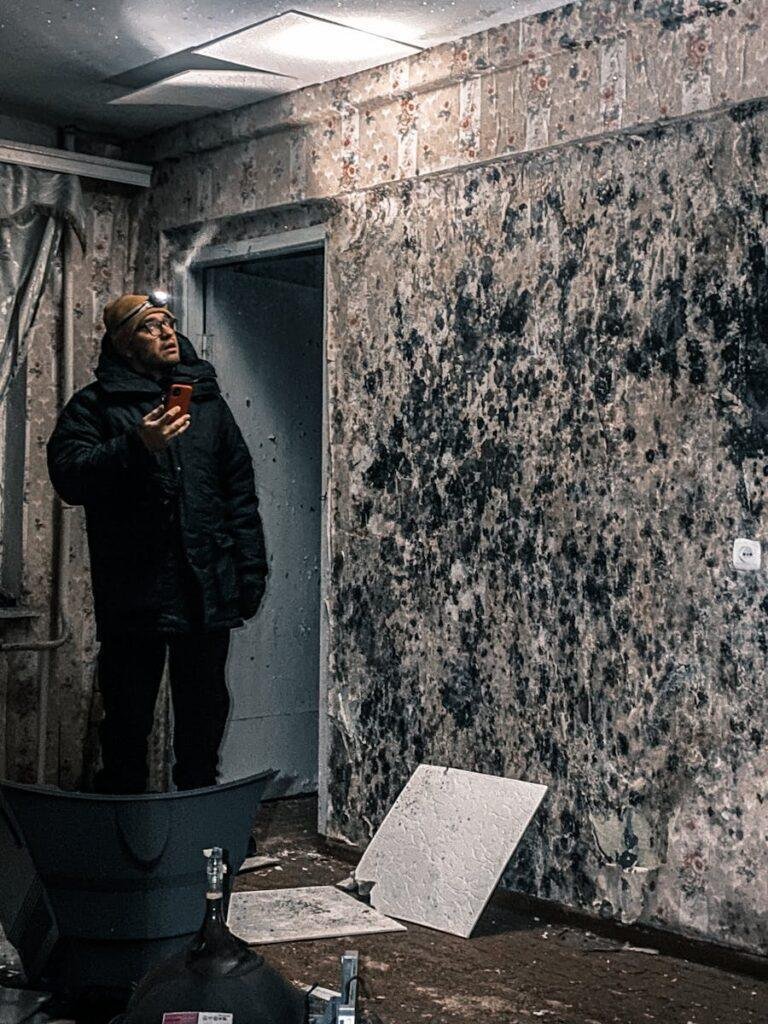Is White Mold in the Attic Bad?
What are Mold Spores? What Grow in Attics
Mold is a fungus that breaks down organic matter in the environment. Made up of tiny spores, mold is everywhere, especially in warm, damp, and poorly ventilated areas. In residential homes, the attic is the perfect place for mold to grow, especially white mold, due to the conditions that exist in this area.
Water Damage Restoration
Call 1-833-794-4554
White mold, scientifically known as Sclerotinia sclerotiorum, thrives in high humidity and temperatures between 60°F to 90°F (15°C to 32°C). Attics with leaks, inadequate insulation or poor ventilation become a breeding ground for mold. Basement walls also face mold growth due to moisture seeping through concrete walls and poor ventilation, creating a dark, damp environment for mold to grow. Humidity above 60% is an invitation for mold to grow, while stagnant air prevents moisture from escaping, making it worse.
Apart from humidity and temperature, other factors contribute to mold growth in attics. For example, inadequate ventilation restricts airflow and moisture control, allowing mold spores to settle and germinate. Organic materials like wood, insulation and drywall are food sources for mold, making it grow when conditions are right.
There are many types of mold in attics but white mold is the most concerning. Not as scary as black mold but can still cause health issues and structural problems if left unaddressed.
Exposure to mold spores can cause allergic reactions, respiratory issues and other health problems, that’s why homeowners need to understand how to prevent mold growth in their attics. Identifying mold in the attic and taking action immediately, like hiring a mold remediation company, is key. To prevent this, proper ventilation, reducing moisture and regular attic inspection for mold are necessary.
By doing these preventive measures, the risk of having hazardous white mold in the attic can be minimized.

What causes Mold in the Attic?
Mold in the attic is the result of several factors that create an environment for mold spores to grow. One of the main culprits is excess moisture. High humidity levels, caused by roof leaks or condensation, can create a damp environment for mold to grow. When moisture accumulates on porous surfaces like wood beams and insulation, it becomes a breeding ground for mold.
Poor ventilation is another big factor. Inadequate air circulation prevents moisture from escaping, allowing it to linger and create a humid environment. Stagnant air can worsen mold problems especially in attics where airflow is already limited. Proper ventilation is key to solving this issue.
Warm temperatures also contribute to mold growth. Attics can get hot especially during summer months which can speed up mold growth. Combination of heat and moisture is a conducive environment for mold spores to settle and spread.
Organic materials in the attic such as wood surfaces and insulation are food sources for mold. These materials provide the nutrients mold needs to grow and spread. Without regular maintenance and inspection, these conditions can go unnoticed and mold can take hold and cause damage over time.
By understanding these factors, homeowners can take proactive measures to prevent mold growth in their attics. Addressing moisture issues, improving ventilation and regular attic maintenance are key to keeping mold at bay.
Is White Mold Dangerous? Health Risks and Impact
White mold found in damp areas like attics is a type of fungus that can raise concerns about health and wellness. While some molds are toxic, the danger posed by white mold depends on the individual’s sensitivity to mold spores and existing health conditions. Inhalation of these spores can cause a range of health problems especially for those with pre-existing respiratory conditions, allergies or weakened immune systems.
Individuals exposed to white mold may experience symptoms such as nasal congestion, coughing, skin irritation and even respiratory infections. Symptoms like runny nose is common in individuals exposed to mold especially those with allergies or asthma. These symptoms can be severe in sensitive groups like children, elderly and those with asthma or chronic obstructive pulmonary disease (COPD).
Long term exposure to mold spores in the air can exacerbate these conditions and reduce lung function and put extra burden to the body. Also, white mold can ruin indoor air quality. It releases spores that can spread through the house and add up to the occupant’s exposure.
Degradation of air quality can lead to more serious health problems over time especially in enclosed areas where airflow is limited. Regular monitoring and addressing moisture levels in attics and other susceptible areas is key to controlling mold growth and a healthy living environment.
Not all white mold is bad but can be a health risk under certain conditions. If mold growth is persistent or accompanied by visible signs of damage, action must be taken. Early intervention can minimize health risks and prevent further mold growth. So understanding the danger of white mold is crucial to having a safe indoor space and protecting all residents.
Mold in Your Attic: Signs and Symptoms to Watch Out For
Detecting mold in your attic is key to ensuring your home’s safety and integrity. White mold though often mistaken for other substances has specific characteristics that can help homeowners identify its presence.
Typically white mold appears as a fuzzy or powdery substance on surfaces like wood beams, insulation or roofing materials. It can also appear in different textures like patches or strands which can look like cotton or cobwebs. Knowing these visual cues is important in determining if there is a mold problem.
Aside from visual identification, musty odors are another indicator of mold presence. If you notice a persistent and unpleasant smell coming from your attic it could be an underlying mold issue. Combined with other signs like condensation or water stains on walls and ceilings these odors can be important clues.
Moisture detection is critical as mold thrives in damp environment. Use a moisture meter to measure humidity in your attic; persistent moisture readings can mean an ideal breeding ground for mold growth.
When inspecting your attic space, safety should be your top priority. Always wear protective gear like gloves, goggles and mask to minimize exposure to mold spores which can be harmful when inhaled. If the area is large or you suspect extensive mold growth it’s best to seek professional help.
Experts can do a comprehensive mold assessment and remediation to ensure any hazards associated with white mold in the attic are addressed. By being vigilant and proactive you can protect your home from mold risks.## What to Do If You Suspect Mold in Your Attic: Step-by-Step Mold Inspection Plan
When homeowners find out they have mold in their attic especially white mold it’s time to act fast and cautious. The first step is to prioritize safety. Before any inspection put on protective gear like gloves, goggles and mask that can filter out mold spores. This is important as exposure can cause health problems.
Next do a visual inspection of the attic. Look for signs of mold growth which often appears as patchy white or gray spots on wood, insulation or other materials. Also take note of areas with water damage or excessive moisture as these are usually indicators of underlying problems that can promote mold growth.
Once the mold is visually identified assess the extent of the infestation. If the mold is small less than 10 square feet it might be manageable for a homeowner to do. In this case use a mixture of water and dish soap or a specialized mold-killing solution for removal. Make sure to ventilate during cleaning and dispose of any contaminated materials properly.
However if the mold is extensive or you feel hesitant to do it yourself professional mold removal services are necessary. These experts can assess the situation, identify the root cause of mold growth and implement effective remediation strategy. They can also ensure that the mold does not come back which is a critical aspect of long-term mold management. When removing mold it’s important to use the right techniques and safety precautions to avoid health risks and further contamination.
To prevent future mold growth in your attic focus on ventilation and humidity control. Install vents, use exhaust fans or even dehumidifiers to reduce moisture and therefore prevent mold growth. Regular inspections and maintenance is key to having a safe and mold-free attic space.

Preventing Mold Growth in the Attic
Preventing mold growth in the attic requires a proactive approach that focuses on good ventilation, regular maintenance and addressing any underlying moisture issues. Here are some practical tips to help you keep your attic mold-free:
- Proper Ventilation: Good air circulation is key to preventing mold growth. Install vents and make sure they are working properly to allow fresh air to flow through the attic. Use exhaust fans to further improve air circulation.2. Moisture Control: Moisture is key to mold. Fix any roof leaks ASAP to prevent water from entering the attic. Make sure the attic is well-insulated to prevent condensation from forming on surfaces. Use a dehumidifier to control moisture especially in humid areas.
- Regular Attic Inspection: Regular inspection is crucial in catching mold problems early. Look for signs of mold growth such as black spots, white patches or musty smell. If you detect any of these signs address the issue immediately to prevent it from spreading.
- Keep the Attic Clean: Remove any debris or organic materials that can be a food source for mold. This includes old cardboard boxes, fabric and other materials that can retain moisture. Keeping the attic clean and clutter-free reduces the chances of mold to grow.
- Mold-Resistant Coating: Apply a mold-resistant coating to wood surfaces and other materials in the attic to add an extra layer of protection. These coatings inhibit mold growth and can be effective in areas with high humidity.
Water Damage Restoration
Call 1-833-794-4554
Conclusion
By now you should know if white mold is dangerous. By following these tips you can create an environment in your attic that is less conducive to mold growth. Regular maintenance and vigilance is key to preventing mold-related health problems and extending the life of your home.


